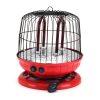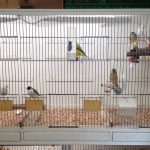Australia is home to a wide variety of finches, many of which have become popular pets thanks to their vibrant plumage, ease of care, and rapid breeding.
Among the most notable is the Gouldian Finch, admired worldwide for its stunning colors. However, it was trapped for aviculture to such an extent that it is now considered endangered in the wild in Australia. Another well-known species is the Zebra Finch, which is extensively studied for its exceptional ability to adapt to captivity.
List of Finches Native to Australia
All the finches native to Australia are from the family of estrildid finches (Estrildidae). They are small, usually between 4 and 6 inches in length, and known for the bright colors and patterns of their plumage.
| Name | Where They Are From |
|---|---|
| Endemic | |
| Diamond Firetail | Grassy open areas from southeast Queensland to the Eyre Peninsula in South Australia |
| Beautiful Firetail | Coastal heathland, forests, and shrubbery in southeastern Australia, from Newcastle to Kangaroo Island, with a high population density in Tasmania |
| Double-barred Finch | Tropical dry grassland and shrubland habitats in northern and eastern Australia, from north Western Australia and Queensland and the Northern Territory, to southeast New South Wales |
| Gouldian Finch | Mountain slopes with sparse vegetation in northern Australia, with high population density in the Kimberley region and the Northern Territory |
| Masked Finch | Areas near water in dry savannah across northern Australia, from the Kimberley region to the Top End, the Gulf country, and the southern Cape York Peninsula, extending east to Chillagoe |
| Black-throated Finch | Grassy open forested habitats, from Cape York south to eastern Queensland |
| Long-tailed Finch | Open woodlands in northern Australia, from the Kimberley region to the Gulf of Carpentaria |
| Painted Firetail | Arid and semi-arid rocky areas with patches of spinifex grass across the states of Western Australia, Queensland, and South Australia, and the Northern Territory |
| Pictorella Mannikin | Dry savannah and lowland grasslands across northern Australia in states like Western Australia and Queensland, as well as the Northern Territory |
| Plum-headed Finch | Dry savannah and lowland grasslands across eastern Australia |
| Red-browed Finch | Dry savannah and temperate forests in the southeastern regions of Australia, ranging from Brisbane to Melbourne |
| Star Finch | Damp grasslands and sedge lands around water bodies in northern Australia, from the Pilbara, Fitzroy River Valley, and the Wyndham, and Kununurra regions of Western Australia, extending to the western part of the Northern Territory as well as Queensland |
| Yellow-rumped Mannikin | Tropical mangroves, moist savannah, and wetlands across the eastern Kimberley region and north-west Northern Territory |
| Non-endemic | |
| Australian Zebra Finch | Arid areas in central and eastern Australia, as well as Portugal and Costa Rica |
| Blue-faced Parrotfinch | Rainforests and dense grasslands in Australia, New Guinea, Japan, Indonesia, Micronesia, New Caledonia, Palau, Vanuatu and the Solomon Islands |
| Chestnut-breasted Mannikin | Reed beds, grassy areas near rivers, swamps, mangroves, cane fields, and cereal crops in Australia, drier areas in New Guinea; also found in Indonesia and New Caledonia |
| Crimson Finch | Areas with tall, dense grasses and riparian vegetation in the Kimberley region in northern Australia as well as New Guinea |
List of Introduced and Vagrant Finches of Australia
Some finches were either introduced into Australia or arrived by accident as vagrants. This includes estrildid finches as well as others belonging to the family of true finches (Fringillidae). True finches are mostly from places such as Europe and the Americas and are highly adaptive birds capable of thriving in most environments.
Estrildid Finches
- Chestnut Munia
- Java Sparrow
- Scaly-breasted Munia
- Pale-headed Munia (vagrant)
True Finches
- Common Redpoll
- European Goldfinch
- European Greenfinch
- Lesser Redpoll
- Common Chaffinch (vagrant)
From arid regions to coastal areas, Australia’s finches have thrived in multiple varied habitats. This adaptability not only highlights their resilience but also contributes to their popularity as pets.






